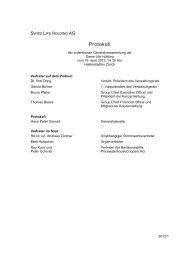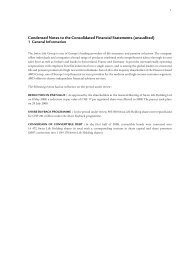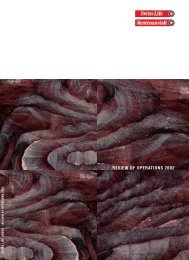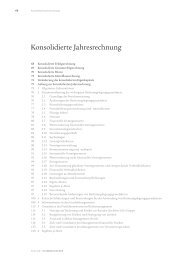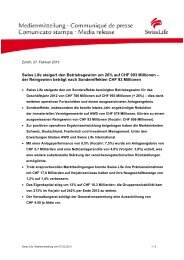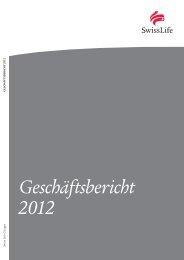Annual Report 2012 - Swiss Life
Annual Report 2012 - Swiss Life
Annual Report 2012 - Swiss Life
Create successful ePaper yourself
Turn your PDF publications into a flip-book with our unique Google optimized e-Paper software.
120 Consolidated Financial Statements<br />
the property is measured at cost until either its fair value becomes reliably measurable or construction<br />
is completed.<br />
Investment property being redeveloped for continuing use as investment property, or for which the<br />
market has become less active, continues to be measured at fair value.<br />
If an item of property and equipment becomes an investment property because its use has changed,<br />
the positive difference resulting between the carrying amount and the fair value of this item at the<br />
date of transfer is recognised in equity as a revaluation surplus. However, if a fair value gain reverses<br />
a previous impairment loss, the gain is recognised in the income statement. Any resulting decrease in<br />
the carrying amount of the property is recognised in net profit or loss for the period. Upon the disposal<br />
of such investment property, any surplus previously recorded in equity is transferred to retained<br />
earnings; the transfer is not made through income.<br />
If an investment property becomes owner-occupied, it is reclassified as property and equipment, and<br />
its fair value at the date of reclassification becomes its cost for subsequent accounting purposes.<br />
2.10 Insurance operations<br />
Definition of insurance contracts<br />
Insurance contracts are contracts under which one party accepts significant insurance risk from<br />
another party (the policyholder) by agreeing to compensate the policyholder if a specified uncertain<br />
future event adversely affects the policyholder. Significant insurance risk exists if an insured event<br />
could cause an insurer to pay significant additional benefits in any scenario, excluding scenarios that<br />
lack commercial substance (i.e. have no discernible effect on the economics of the transaction). The<br />
classification of contracts identifies both the insurance contracts that the Group issues and reinsurance<br />
contracts that the Group holds. As a Group policy, <strong>Swiss</strong> <strong>Life</strong> considers those contracts to be<br />
insurance contracts that require the payment of additional benefits in excess of 10% of the benefits<br />
that would be payable if the insured event had not occurred, excluding scenarios that lack commercial<br />
substance.<br />
The Group has assessed the significance of insurance risk on a contract-by-contract basis. Contracts<br />
that do not transfer insurance risk at inception but that transfer insurance risk at a later date are<br />
classified as insurance from inception unless the Group remains free to price the insurance premium<br />
at a later date. In this case, the contract is classified as insurance when the insurance premiums are<br />
specified. A contract that qualifies as an insurance contract remains an insurance contract until all<br />
rights and obligations are extinguished or expire.<br />
Contracts under which the transfer of insurance risk to the Group from the policyholder is not significant<br />
are classified as investment contracts.<br />
Investment contracts with and without discretionary participation features<br />
For investment contracts that contain discretionary participation features (see below) the same recognition<br />
and measurement principles as for insurance contracts apply. For investment contracts without<br />
discretionary participation features the recognition and measurement rules for financial instruments<br />
apply.<br />
<strong>Swiss</strong> <strong>Life</strong> – <strong>Annual</strong> <strong>Report</strong> <strong>2012</strong>



